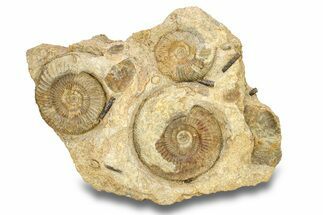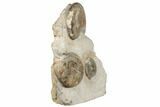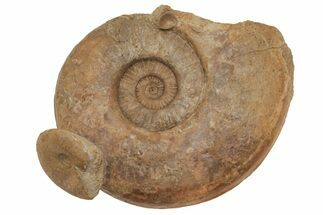This Specimen has been sold.
16" Tall Fossil Ammonite (Parkinsonia) Association - England
This is an absolutely huge Parkinsonia sp. ammonite association from Dorset England. There are three well-preserved ammonites and a small bivalve prepared within the rock in which they were found. The largest ammonite measures 7" wide and has rather unique coloring.
There are a few repaired cracks in the rock that have been stabilized to maintain the specimen's integrity and longevity. The base has been cut flat for ease of display.
There are a few repaired cracks in the rock that have been stabilized to maintain the specimen's integrity and longevity. The base has been cut flat for ease of display.
About Ammonites
Ammonites were ancient marine cephalopods, similar to today's squids and octopuses, but with a defining feature: their distinctive, tightly coiled spiral shells. These shells, resembling those of modern nautiluses, served as both a protective home and a buoyancy aid, allowing ammonites to navigate the prehistoric seas with ease. First emerging around 240 million years ago in the Triassic Period, ammonites thrived for over 175 million years, adapting through numerous forms and sizes. As predatory creatures, they likely fed on smaller marine organisms, using their tentacles to capture prey. However, their long reign came to an end 65 million years ago at the close of the Cretaceous, coinciding with the mass extinction event that also eliminated the dinosaurs.
Ammonites were ancient marine cephalopods, similar to today's squids and octopuses, but with a defining feature: their distinctive, tightly coiled spiral shells. These shells, resembling those of modern nautiluses, served as both a protective home and a buoyancy aid, allowing ammonites to navigate the prehistoric seas with ease. First emerging around 240 million years ago in the Triassic Period, ammonites thrived for over 175 million years, adapting through numerous forms and sizes. As predatory creatures, they likely fed on smaller marine organisms, using their tentacles to capture prey. However, their long reign came to an end 65 million years ago at the close of the Cretaceous, coinciding with the mass extinction event that also eliminated the dinosaurs.
SPECIES
Parkinsonia sp.
LOCATION
Dorset, Great Britain
FORMATION
Upper Inferior Oolite
SIZE
Largest Ammonite: 7" Wide, Entire Specimen: 16.25 x 14.25"
CATEGORY
SUB CATEGORY
ITEM
#191732
We guarantee the authenticity of all of our specimens.
 Reviews
Reviews
















